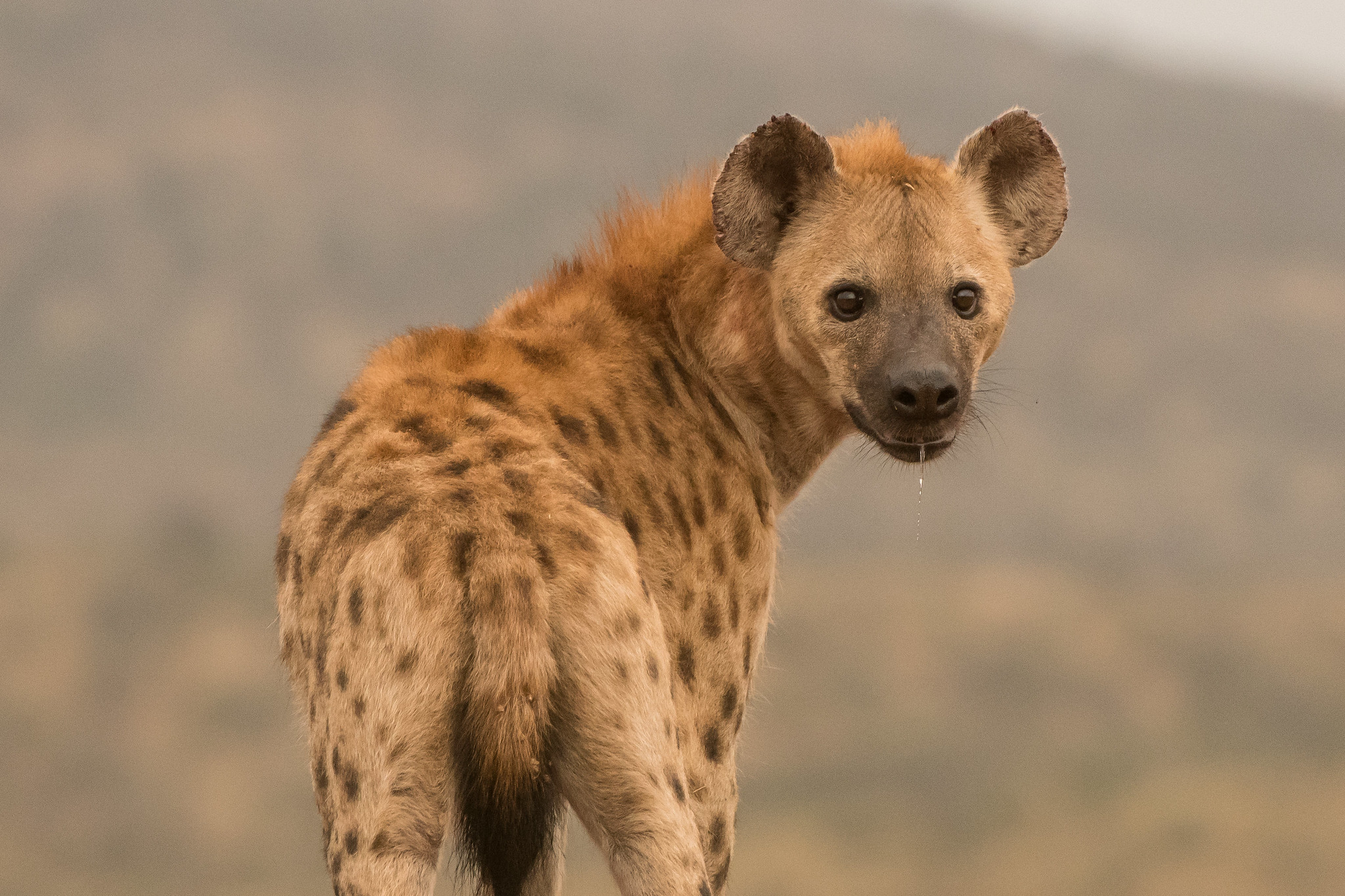10 Fun Facts About Hyenas
10 Fun Facts About Hyenas. People have disliked hyenas for a very long time. People have a bad opinion of hyenas because they think they are mean, scared, and ugly. That’s not all they do. They’re also hunters. There are many interesting things about them and the way they act that help keep the natural world in order.

Here are 10 interesting facts about hyenas that might change the way you feel about these smart, family-oriented animals.
-
Hyenas aren’t dogs or cats.
Many people mistake hyenas for either dogs or cats, but they are actually in their own family, Hyaenidae. People get this wrong because hyenas are like cats and dogs in some ways.
Animals like cats, dogs, bears, and others are in the order Carnivora. The order has three families. Hyenas are in the Hyaenidae family, which is different from the Canidae and Felidae families.
In some ways, hyenas look and act like dogs, but in terms of genetics and taxonomy, they are more closely related to cats in terms of development. It was more recently that they shared an ancestor with feliforms than with caniforms.
-
There are four types of hyenas.
There are four different kinds of hyenas in the Hyaenidae family: the spotted hyena (Crocuta crocuta), the brown hyena (Parahyaena brunnea), the striped hyena (Hyaena hyaena), and the aardwolf (Proteles cristata). There are different types of hyenas, and each one lives in a different area of Africa and some parts of Asia.
The spotted hyena is the most common type of cat in Tanzania. It is known for having spotted hair, a strong body, and a strong jaw. Also living in Tanzania are the brown hyena and the striped hyena, though people don’t see them as often.
-
Hyenas live in groups called clans.
Hyenas live in organized groups called clans and have complicated social habits. Spotted hyenas are one of these groups that behave in very interesting ways. Their homes are matriarchal, which means that women are in charge of the order. The mother usually decides the order of things because she is in charge of hunting and breeding in the group.
In communal dens, hyenas have their babies, and the whole group takes care of the cubs. Hyena cubs grow up very quickly.
-
They’re not having fun when they “laugh”
Hyenas use a lot of different sounds to talk to each other. The hyena’s unique laughing call is one of the most recognizable sounds. It is often mistaken for a sign of happiness. Basically, this sound is a way for people in the clan to talk to each other. A hyena typically laughs in response to fear or an attack.
Hyenas also mark their territory with scents using glands to leave chemical clues. People use these smell marks to mark their territory, share social information, and help the group figure out who they are.
-
Hyenas are good at hunting.
People often think of hyenas as scavengers when they are actually skilled killers and hunters. For example, spotted hyenas are known for how well they can catch food, even animals that are much bigger than them. They hunt by collaborating as a cohesive pack to gain an advantage over their prey and successfully capture it.
Hyenas are very important to the environment because they clean up after other animals. Their scavenging habits help keep the ecosystem in order by lowering the number of dead animals and stopping the spread of disease. As both hunters and scavengers, they are important to the food chain.
-
Hyenas’ jaws are very strong.
Hyenas are very good at breaking bones because they have strong mouths and can bite with a huge force. They are different from many other predators because their strong teeth make it easy for them to break bones and eat them. They can eat almost the whole body, even the bones, which helps the body absorb nutrients better.
Their bite is over 1100 PSI, which makes it one of the strongest in the animal world. The bite force of a lion is 650 PSI, even though they are more than twice as big as a hyena.
-
Hyenas eat everything
Hyenas are opportunistic eaters, which means they can use a variety of food sources. They are good hunters, but they also look for food in other places. Their diet includes a lot of different foods.
Large and Small animals: Hyenas hunt big animals like buffalo, wildebeest, antelope, and zebras. In some places, they are the most common animals that eat these animals. They hunt in groups or pick through the bodies of other predators to find food. In addition, they eat birds, hares, and other small animals.
Carrion and Scavenging: Hyenas are known for picking through trash. They often eat the bodies of dead animals that they can find by smelling them very well. They can break bones, which lets them get marrow out of them and eat parts of the body that other animals can’t.
Insects and Other Small Animals: Sometimes, especially for smaller hyena species like the aardwolf, insects (like termites) and other small animals may make up most of their food.
Fruits and Vegetables: Hyenas usually eat meat, but they have been known to eat some types of fruit and plants when there isn’t enough meat.
Human-derived Waste: Hyenas sometimes eat human garbage or waste in places where people live, which shows that they can adapt to different environments and food sources.
Hyenas also have bad guys. Hyenas are mostly in danger from lions in the wild. There is a lot of direct competition between these two species for food and space. Big cats like leopards and alligators are also dangerous to hyenas.
-
Hyenas can last for a very long time.
Hyenas are known for being very tough, especially when they are hunting or traveling. Because they are very strong, they can go on long chases after their food. While many other predators rely on speed and surprise, hyenas tend to kill by staying alert for a long time. To do this, they have to chase their prey over long distances until the prey gives up.
The hyena’s amazing stamina comes from a number of changes in its body. Hyenas have fantastic lungs, slow-twitch muscle fibers that are perfect for long-lasting activities, and a loping walk that saves them energy.
-
Hyenas don’t just live in the flatlands of Africa
Hyenas usually live in savannas and plains in Africa, but they do well in a wide range of places, including parts of Asia and different parts of Africa.
Some hyena species, like the brown hyena, can live in dry places, even places that aren’t completely desert. There are also places with mountains where they live, like the Ethiopian Highlands. Urban hyenas are becoming more and more common. Also, you can find them in woods and parks.
-
Hyena females have pseudo-penises
Spotted hyena females have a unique body part called a “pseudo-penis.” This part is not a penis, but an enlarged clitoris that looks a lot like a male’s penis in terms of size and shape. They are the only female mammals that can mate, pee, and give birth through a tube that looks like a penile. Getting an erection is even possible for females!
There are a few different ideas about why they are this way. In this case, it might be a way of showing acceptance or peace. It could give female hyenas more power over mating since the structure only lets the male and female mate if the female is fully cooperative. It could also be a side effect of having a lot of androgens (male hormones) in their bodies.
Hyena with Spots: Quick Facts
Crocuta crocuta is its scientific name.
Spotted hyena is its common name.
Size: 2.5 feet tall, 3.3 to 5.2 feet long, and 10 to 14 feet long at the tail.
90 to 190 pounds
12 to 20 years of life
Food: carnivore
Sub-Saharan Africa is their home.
Status of the conservation: least concern
Even though hyenas are not considered rare right now, they do face many problems, such as losing their habitat and getting into fights with people. To make sure they can live with people in the area and be safe in national parks and forests, conservation efforts are necessary.
10 Fun Facts About Hyenas. Hyenas are important to many Tanzanian communities’ cultures, and they show up in a lot of folklore and customs. For tourists and animal lovers, seeing these smart and tough predators on safaris and game drives is an interesting and educational experience.


















